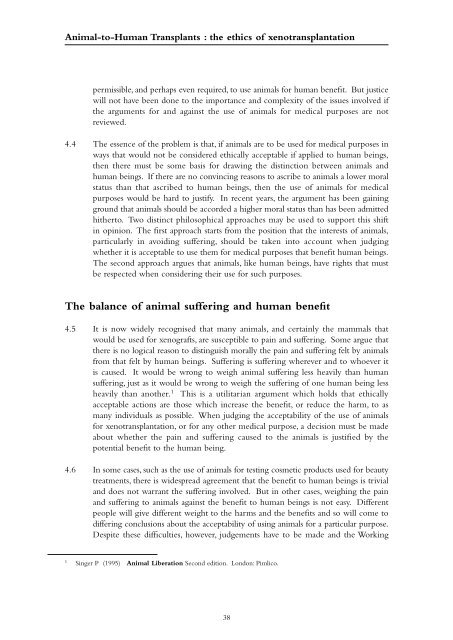Xenotransplantation - Nuffield Council on Bioethics
Xenotransplantation - Nuffield Council on Bioethics
Xenotransplantation - Nuffield Council on Bioethics
Create successful ePaper yourself
Turn your PDF publications into a flip-book with our unique Google optimized e-Paper software.
Animal-to-Human Transplants : the ethics of xenotransplantati<strong>on</strong><br />
permissible, and perhaps even required, to use animals for human benefit. But justice<br />
will not have been d<strong>on</strong>e to the importance and complexity of the issues involved if<br />
the arguments for and against the use of animals for medical purposes are not<br />
reviewed.<br />
4.4 The essence of the problem is that, if animals are to be used for medical purposes in<br />
ways that would not be c<strong>on</strong>sidered ethically acceptable if applied to human beings,<br />
then there must be some basis for drawing the distincti<strong>on</strong> between animals and<br />
human beings. If there are no c<strong>on</strong>vincing reas<strong>on</strong>s to ascribe to animals a lower moral<br />
status than that ascribed to human beings, then the use of animals for medical<br />
purposes would be hard to justify. In recent years, the argument has been gaining<br />
ground that animals should be accorded a higher moral status than has been admitted<br />
hitherto. Two distinct philosophical approaches may be used to support this shift<br />
in opini<strong>on</strong>. The first approach starts from the positi<strong>on</strong> that the interests of animals,<br />
particularly in avoiding suffering, should be taken into account when judging<br />
whether it is acceptable to use them for medical purposes that benefit human beings.<br />
The sec<strong>on</strong>d approach argues that animals, like human beings, have rights that must<br />
be respected when c<strong>on</strong>sidering their use for such purposes.<br />
The balance of animal suffering and human benefit<br />
4.5 It is now widely recognised that many animals, and certainly the mammals that<br />
would be used for xenografts, are susceptible to pain and suffering. Some argue that<br />
there is no logical reas<strong>on</strong> to distinguish morally the pain and suffering felt by animals<br />
from that felt by human beings. Suffering is suffering wherever and to whoever it<br />
is caused. It would be wr<strong>on</strong>g to weigh animal suffering less heavily than human<br />
suffering, just as it would be wr<strong>on</strong>g to weigh the suffering of <strong>on</strong>e human being less<br />
heavily than another. 1 This is a utilitarian argument which holds that ethically<br />
acceptable acti<strong>on</strong>s are those which increase the benefit, or reduce the harm, to as<br />
many individuals as possible. When judging the acceptability of the use of animals<br />
for xenotransplantati<strong>on</strong>, or for any other medical purpose, a decisi<strong>on</strong> must be made<br />
about whether the pain and suffering caused to the animals is justified by the<br />
potential benefit to the human being.<br />
4.6 In some cases, such as the use of animals for testing cosmetic products used for beauty<br />
treatments, there is widespread agreement that the benefit to human beings is trivial<br />
and does not warrant the suffering involved. But in other cases, weighing the pain<br />
and suffering to animals against the benefit to human beings is not easy. Different<br />
people will give different weight to the harms and the benefits and so will come to<br />
differing c<strong>on</strong>clusi<strong>on</strong>s about the acceptability of using animals for a particular purpose.<br />
Despite these difficulties, however, judgements have to be made and the Working<br />
1<br />
Singer P (1995) Animal Liberati<strong>on</strong> Sec<strong>on</strong>d editi<strong>on</strong>. L<strong>on</strong>d<strong>on</strong>: Pimlico.<br />
38
















